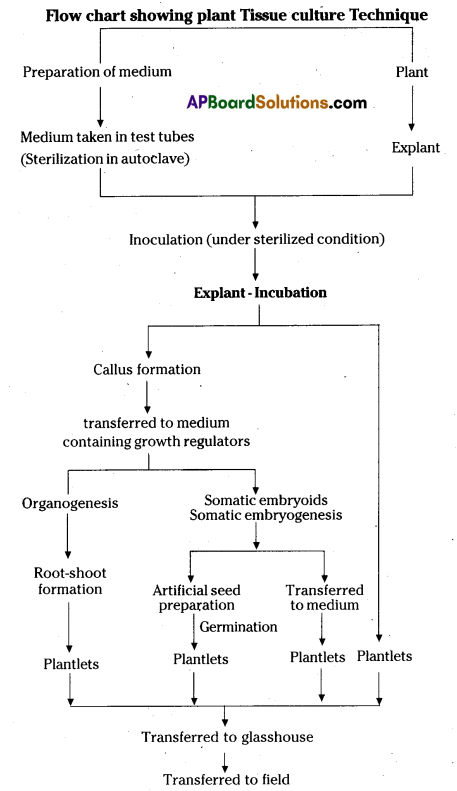Thoroughly analyzing TS Inter 2nd Year Botany Model Papers and TS Inter 2nd Year Botany Question Paper May 2016 helps students identify their strengths and weaknesses.
TS Inter 2nd Year Botany Question Paper May 2016
Time: 3 Hours
Max Marks: 60
Note: Read the following instructions carefully:
- Answer all questions of Section ‘A’. Answer any six questions out of eight in Section ‘B’ and answer any two questions out of three in Section ‘C’.
- In Section ‘A’, questions from Sr. Nos. 1 to 10 are of “Very Short Answer Type”. Each question carries two marks. Every answer may be limited to 5 lines. Answer all the questions at one place in the same order.
- In Section ‘B’, questions from Sr. Nos. 11 to 18 are of “Short Answer Type”. Each question comes four marks. Every answer may be limited to 20 lines.
- In Section ‘C’, questions from Sr. Nos. 19 to 21 are of “long Answer Type”. Each question comes eight marks. Every answer may be limited to 60 lines.
- Draw labelled diagrams wherever necessary for questions in Section ‘B’ and ‘C’.
Section- A
10 x 2 = 20
Note: Answer all questions. Each answer may be limited to 5 lines.
Question 1.
Name the essential elements present in the nitrogenase enzyme. What type of essential elements are they?
Answer:
Nitrogenase enzyme contains Mo (Molybdenum) and Fe (Iron) elements. They are microelements.
Question 2.
Define the law of limiting factors proposed by Blackman.
Answer:
In a process participated by a number of separate factors, the rate of the process is limited by the factor which is present in minimal value is called law of imiting factor.
Question 3.
What is the shape of T4 phage? What is its genetic material?
Answer:
The shape of T4 phase is tadpole shape. Its genetic material is Double-stranded DNA.
Question 4.
Define true breeding. Mention its significance.
Answer:
Plants produce only offsprings of the same variety when they self-pollinate is called true breeding. The offspring express characters for several generations.
![]()
Question 5.
In a typical DNA molecule, the proportion of thymine is 30% of the N bases. Find the percentage of other N bases.
Answer:
A = T, G = C so Adenine is 30%, Guanine is 20% and Cytosine is 20%.
Question 6.
What is the function of the codon ‘AUG’?
Answer:
It has dual functions. It codes for Methionine (an amino acid) and a1o acts as initiator codon.
Question 7.
Define biotechnology.
Answer:
It is a science which utilize properties and uses of microorganisms or exploits cells and the cell constituents of the industrial level for generating useful products essential to life and human welfare.
Question 8.
Give the different types of ‘Cry’ genes and pests, which are controlled by the proteins encoded by these genes.
Answer:
The proteins encoded by the genes cry IAC and cry IIAB control the cotton ball worms. Cry ¡AB controls corn borers Cry protein is a protein toxin produced by Bacillus thuringiensis that kills insects.
Question 9.
Name a microbe used for statin production. How do statins lower blood cholesterol level?
Answer:
Moascus purpure us Statins act by competitively inhibiting the enzyme responsible for the synthesis of cholesterol.
Question 10.
Name an immunosuppressive agent. From where it is obtained?
Answer:
Cyclosporin – A. It is obtained from the fungus Trichoderma polysporum.
![]()
Section – B
6 x 4 = 24
Note: Answer any six questions. Each answer may be limited to 20 lines.
Question 11.
What is meant by plasmolysis? How is it practically useful to us?
Answer:
The phenomenon of shrinkage of protoplast due to osmotic diffusion of water from the cells into the surrounding environment is called plasmolysis. When a cell is placed in high concentrated solution, water moves out through osmosis. As a result, the protoplasm undergoes shrinkage leads to the separation of plasma membrane from the cell wall in the corners called incipient plasmolysis. The salting of pickles and preserving of fish and meat in salt are good examples of practical applications.
Question 12.
Explain the different types of cofactors.
Answer:
Co-factors are of two types.
They are:
a) Metal ion co-factors: Metallic cations get tightly attached to the apoenzyme are called metalloenzymes.
Ex: Cu2+ cytochrome oxidase.
b) Organic co-factors: They are of two, types.
1. Co-enzymes: They are the small organic molecules which are loosely associated with the Appoenzyme.
Ex: Thiamine pyrophosphate-Vitamin B1.
2. Prosthetic group: They are the organic co-factors which are tightly bound to the Apo-enzyme.
Ex: Haeme is the prosthetic group of enzyme Peroxidase.
Question 13.
Describe C4 pathway.
Answer:
In tropical plants like sugarcane and Maize, carbon is fixed by B-carboxylation or Hatch slack pathway. In this, first formed product is OAA (4C compound) is called C4 cycle. In C4 plants bundle sheath cells show Kranz anatomy
i) Wreath-like arrangement. In Mesophyll cells, general chloroplasts, and in bundle sheath cells, agranal chloroplasts are seen.
Reactions: In Mesophyll cells:
1. CO2 is accepted by PEPA to form OAA in the presence of PEP carboxylase.
CO2 + PEPA + H2O → OAA + H3PO4.
2. OAA undergoes a reduction in the presence of Malic dehydrogenase to form Malic acid.
OAA +NADPH+H+ → MA+NADP+
In bundle sheath cells:
3. MA formed in chloroplasts of Mesophyll cells moves into Bundle sheath cells, undergoes oxidation and phosphorylation to form PA and CO2 in the presence of Dehydrogenase.
MA+NADP+ → PA + CO2 + NADPH + H+
4. CO2 liberated in Bundle sheath cells is fixed through Calvin cycle to synthesize sugars.
CO2 + RUBP → Sugar
5. PA formed in Bundle sheath cells moves into Mesophyll cells, phosphorylated in the presence of kinase to form PEPA.
PA+2ATP → PEPA + 2AMP + 2PPi
In C4 cycle, 2 carboxylations and one Decarboxylation occurs. 30 ATP molecules, 12 NADPH + H+ are required to synthesize 1 Glucose molecule.
![]()
Question 14.
Write any four physiological effects of cytokinins in plants.
Answer:
- Cytokinins induce cell division.
- They help to produce new leaves, chloroplasts in leaves, lateral shoot growth and adventitious shoot formation.
- They help to overcome the apical dominance.
- They delays the leaf senescence.
- They help in stomatal opening by increasing K+ ions in guard cells.
Question 15.
How are bacteria classified on the basis of number and distribution of flagella?
Answer:
Depending on the number and distribution of flagella, bacteria are classified into 4 types.
They are:
- Monotrichous: A single flagellum is present on one side of the cell.
- Lophotrichous: Two or more flagella are present on one side of the cell.
- Amphitrichous: Single flagellum on either side of the cell.
- Pedtricbous: Many flagella are distributed over the entire cell.

Question 16.
Explain the codominance with an example.
Answer:
The phenomenon of where heterozygotes have features of both the homozygotes that is an allele is neither dominant or recessive to other is called. codominance.
Ex: Seed coat pattern and size in lentil plants.
Across between pure breeding spotted lentils with pure breeding dotted lentils with pure breeding dotted lentils produces heterozygotes. These F1 hybrids show the phenotypic features of both parents which means that neither the spotted nor the dotted allele is dominant or recessive to the other because both the traits show up equally in the heterozygotes phenotype, the alleles are termed co-dominant. F1 plants are self-pollinated and produce F2 progeny in the ratio of 1 spotted: 2 spotted and dotted: and 1 dotted.
![]()
Question 17.
Draw the schematic/diagrammatic presentation of the lac operon.
Answer:
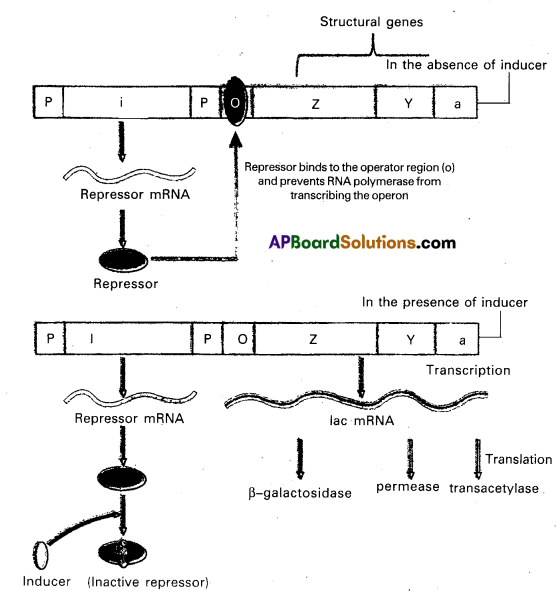
Question 18.
What are some biosafety issues concerned with genetically modified crops?
Answer:
- There is a fear of transferring allergins or toxins to humans and animals as side effects.
- There is a risk of changing the fundamental nature of vegetables.
- They may pose a harmful effect on biodiversity and have an adverse impact on environment.
- There is a risk of gene pollution due to transfer of new genes into related wild species through natural outcrossing. This may result in the development of super weeds which may be fast growing than the crops and may be resistant to weedicides.
- They may bring about changes In natural evolutionary patterns.
Section – C
2 x 8 = 16
Note: Answer any two questions. Each answer may be limited to 60 lines.
Question 19.
Explain the reactions of Kreb’s cycle.
Answer:
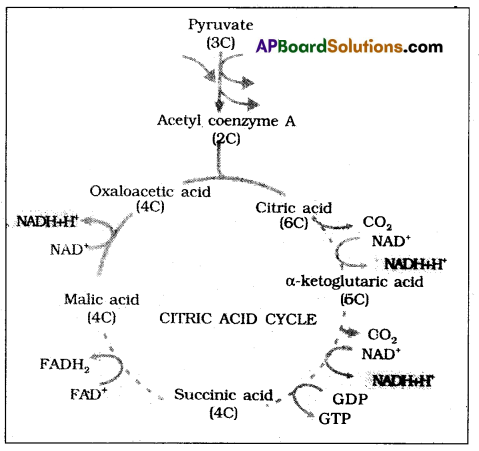
The acetyl CoA eaters into the [mitochondrial matrix] a cyclic pathway tricarboxylic acid cycle, more commonly called krebs cycle after the scientist Hans Krebs who first elucidated it.
1. Condensation: In this acetyl CoA condenses with oxaloacetic acid and water to yield citric acid in the presence of citrate synthetase and CoA is released.
![]()
2. Dehydration: Citric acid looses water molecule to yield cis aconitic acid in the presence of aconitase.
![]()
3. Hydration: A water molecule is added to cisaconic acid to yield isocitric acid in the presence of a conitase.
![]()
4. Oxidation I: Isocitric acid undergoes oxidation in the presence of dehydrogenase to yield succinic acid

5. Decarboxylation: Oxalosuccinic acid undergoes decarboxylation in the presence of decarboxylase to form α-keto glutaric acid.

6. Oxidation II, decarboxylation: α – keto glutaric acid undergoes oxidation and decarboxylation in the presence of dehydrogenase and condenses with co.A to form succinyl Co. A.

7. Cleavage: Succinyl Co.A splits into succinic acid and Co..A in the presence of thiokinase to form succinic acid. The energy released is utilised to form ATP from ADP and PI.

8. Oxidation – III: Succinic acid undergoes oxidation and forms Fumaric acid in the presence of succinic dehydrogenase.

9. Hydration: A water molecule is alcohol to Fumaric acid in the presence of Fumarase to form Malic acid.
![]()
10. Oxidation W: Malic acid undergoes oxidation in the presence of malle dehydrogenase to form oxaloacetic acid.

In TCA cycle, for every 2 molecules of Acetyl Co.A undergoing oxidation, 2 ATF 8 NADPH+ H+, 2FADH2 molecules are formed.
![]()
Question 20.
Explain briefly, the various processes of recombinant DNA technology.
Answer:
The important method in recombinant DNA technology ar performed through genetic engineering.
They are:
- Isolation of a desired gene
- Insertion of isolated gene into a suitable vector
- introduction of the recombinant vector into a host and
- Selection of the transformed host cells.
I) Isolation of a desired gene:
- The desired gene is isolated from the donor cell. Normally bacteria are the source of desired genes.
- The cell walls of bacteria are degraded with the help of enzymes.
- The cell membranes are lysed with the help of detergents.
- By treating the cellular constituents with phenols and suitable nucleases and by subjecting to gradient centrifugation, pure DNA is isolated.
- The purified DNA is cut into a number of fragments by restriction endonucleases.
- The restriction enzymes cleave DNA molecules in two ways.
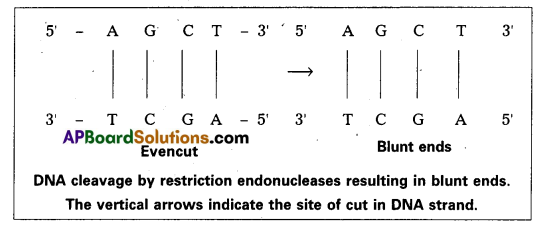
i) In one way they cut both strands of DNA at exactly opposite points to each other. This results in DNA fragments with blunt ends or flush ends, where two strands end at the same point. Such cut is generally termed as even cut.
ii) But commonly, most enzymes cut the two strands of DNA double helix at different locations. Such a cleavage Is generally termed as staggered cut. This generates protruding ends i.e., one strand of DNA double helix extends some bases beyond the other. Since the target site is palindromic in nature, the protruding ends generated by such a cleavage have a complementary base sequence. As a result, they readily pair with each other and such ends are called cohesive or sticky ends. This stickyness of the ends facilitates the action of the enzyme DNA ligase. When cut by the same restriction enzyme, the resultant DNA fragments have the same kind of ‘sticky ends’ and these can be joined together readily by using DNA ligases.
E.g.: The restriction enzyme E coRI.
E – The first letter, represents the name of genus Escherichia.
Co – The next two letters, represent the species Escherichia Coil.
The letter R is derived from the name of strain.
Roman numbers following the names indicate the order in which the enzymes were isolated from the strain of bacteria.
This enzyme specifically recognises GAA sites on the DNA and cuts it between G and A (G ↓A).

The resultant fragments are separated from each other by gel electrophores.
The desired fragments are selected by Southern blotting technique.
II) Insertion of Isolated gene into a suitable vector:
- The selected fragments of DNA are inserted into a suitable vector to produce a large number of copies of genes.
- This is called gene cloning.
- There are two major types of vectors, namely plasmids and bacteriophages.
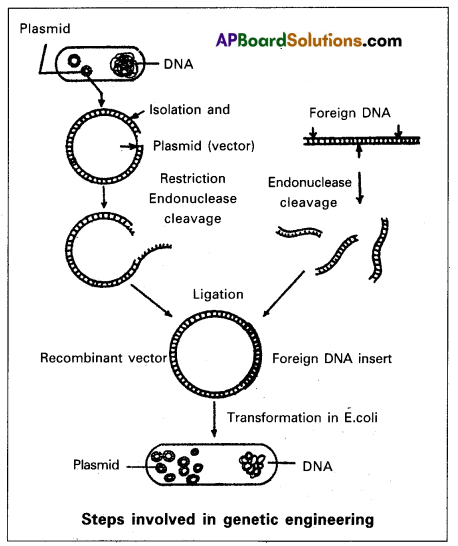
- Among the two types, plasmids are the ideal cloning vectors.
- To isolate a plasmid, the Bacterial cell is treated with EDTA (Ethylene diamine tetra acetic acid) along with lysozyme enzyme to digest the cell wall.
- Then the bacterial cell is subjected to centrifugation in sodium lauryl sulphate to separate the plasmid.
- The plasmid DNA is cut with the help of restriction endonuclease:
- The circular plasmid is converted into a linear molecule having sticky ends.
- The two sticky ends of Linear plasmid are joined to the ends of desired gene by DNA ligase.
- The plasmid containing foreign DNA segments is called recombinant DNA (r DNA) or Chimeric DNA.
III) Introduction of recombinant vector into a suitable host:
- The rDNA molecule is introduced into suitable bacteria) host cell by transformation.
- The cell containing r DNA is called transformed cell.
- Bacterial cell walls are not permeable to recombinant vectors, but keeping in dii. Calcium chloride renders the bacterial cell wall permeable to recombinant vectors.
- The rDNA replicates with in the host cell.
- The transformed cell grows on the culture medium. Each daughter cell contains r DNA.
IV) Selection of transformed host cells:
1. The selection of transformed cells depends on the nature of gene which is cloned.
2. It can be done in two ways. They are:
- Without using probes
- By using probes.
a) Without using probes: .
- If the gene ¡s cloned for antibiotic resistance, the cells are first incubated on a medium without antibiotic for one hour, to allow the antibiotic resistance gene to be expressed.
- Then the cells are placed on a medium with an antibiotic for selection of colonies containing rDNA.
- The cells which have expressed the gene will survive and the others die.
b) By using probes: When transformed cells are cultured on the nutrient medium, several cells are produced. To select the cells containing the desired genecolony hybridization method is used. in this gene specific probes are used. A probe is a small fragment of single-stranded RNA or DNA which ¡s tagged with radioactive, molecule. It can search out complimentary DNA sequences from an organism.
Question 21.
Describe the tissue culture technique. What are the advantages of tissue culture over conventional methods of plant breeding in crop improvement programmes?
Answer:
Tissue culture techniques: It involves
a) Preparation of Nutrient medium: The nutrient medium is a mixture of various essential nutrients, Amino acids, vitamins, and carbohydrates. These are mixed in distilled water and pH is adjusted to 5.6 to 6.0 growth regulators like auxins, and cytokinins are added to the medium. The nutrient medium is powered in glass vessels and closed tightly with cotton plugs before sterilizing them in an Autoclave.
b) Sterllisatlon: The nutrient medium is rich in nutrients and therefore attacks the growth of microorganisms. The culture medium is autoclaved for 15 mins at 121°C or 15 pounds of pressure to make aseptic.
c) Preparation of explant: Any living of plant can be used as explant. The explants must be cleaned with liquid detergent and in running water and surface sterilised with sodium hypochlorite and rinsed with distilled water.
d) Inoculation of explants: The transfer of explants onto the sterilized nutrient medium is called inoculation. It is carried out under sterilized condition.
e) Incubation: The culture vessels with inoculated explants are incubated in a culture room under controlled temperature, optimum light and humidity. The cultures are incubated for 3-4 weeks, the cells of the explants divide and redivide, producing a mass of tissue called callus. The callus is transferred to another medium containing growth regulators to initiate the formation of roots and leafy shoot. Sometimes embryo-like structures develop directly from the callus which are referred as somatic embryos. These can be encapsulated with sodium alginate to form synthetic or artificial seeds.
f) Acciamatizatlon and transfer to pots: The plants produced through tissue culture are washed gently and are planted in pots kept in glass house for 1-2 weeks. Finally, they are transferred to field.
![]()
Advantages:
- More number of plants are produced within a short period and in a little space. (Micropropagation).
- Virus-free plants are produced through meristem culture.
- Somacloned variations ¡n plants and used in plant breeding.
- Synthetic or artificial seeds are produed by encapsulation of embryoids with sodium alginate.
- The production of exact copies of plants that produce particularly good flowers, and fruits.
- To quickly produce mature plants.
- The production of multiples of plants in the absence of seeds or necessary pollinators to produce seeds.
- The regeneration of whole plants from plant cell that have been genetically modified.
- Virus-free plants are used as cleaned stock for horticulture.
